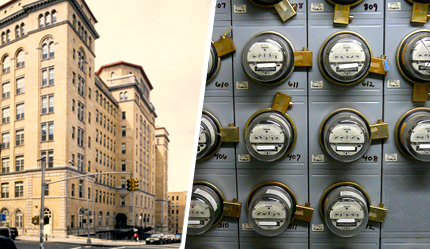Keeping City Beaches Safe and Clean

ALSO:
Touring the Urban Riviera:
An audio slide show of New York's public beaches.
The Bronx's Secret Shore:
Unbeknownst to the vast majority of its residents, the Bronx serves as home to a number of private beach clubs.
Whistle While You Work:
The job is outside, you wear a bathing suit -- and the city usually has openings.
Coney Island Roller Coaster:
The fight over how to develop the famed beach continues with fate of the famed rides and amusements at stake.
New York's Best and Worst Beaches:
They are both on Staten Island but there the similarities end.
Music throbs from the cement steps as gawkers line railings and eye young women in bikinis at the Bronx's Orchard Beach. Umbrellas and sunbathers stretch out seemingly for miles -- tiny specs of blue, red and yellow, loaded with sunscreen and wide-rimmed sunglasses.
It's July. It's Saturday, and the city has turned out to catch some sun.
Among those sunbathers are Silvia and Paul Martinez, a brother and sister from Castle Hill who have made the Bronx's only public beach a routine visit during their summer days. Silvia, 18, may enjoy Orchard Beach, but she wasn't shy about admitting its drawbacks.
"We're not going to deny it," Silvia said as she eyed her sibling splashing in the waves. "It's dirty."
That perception is not uncommon.
While the seven city parks department beaches meet federal health standards and attracted an estimated 15 million visitors last year, they have their shortcomings. It's the litter, and it's the water quality, say beachgoers. Overall, our city beaches have an inferior reputation -- some say unjustly -- compared to suburban sunbathing spots.
Officials, advocates and others argue the city shore offers amenities you can't get on Long Island -- swimming with a view of the Verrazano-Narrows Bridge or being able to leave nature's waves for the ups and downs of The Cyclone -- and the quality of its facilities has improved.
Urban beaches, though, pose special challenges for the parks officials who run them. The shore offers relief from our cement landscape but it also is very much a part of the city. That gives the beaches a kind of gritty charm but also presents huge problems in terms of pollution, debris and ordinary litter.
Sewage Water

As the Mermaid Parade trekked down Coney Island's boardwalk last month -- solidifying the start of the city's official beach season -- Joyce and Peter Jagassar of the Bronx poured beer into plastic cups and dug their feet into the sand.
The Jagassars travel nearly two hours to Coney Island because they think it's cleaner than their own borough's Orchard Beach. Even at Coney Island, though, while they enjoy the vista, they stay clear of the water.
"We don't try to go in the water," said Joyce. Pointing to remnants of previous visitors -- the trash they left behind -- she asks, "Would you want that in your bathtub?"
While littering can threaten the water quality, the larger danger is the city's combined sewer and stormwater system, which covers about 60 to 65 percent of the whole city. Heavy rainfalls overwhelm the sewage plants and cause untreated sewage and stormwater to run off into our water bodies. More than one-tenth of an inch of rain can cause the sewage system to reach capacity and overflow into the ocean or the Long Island Sound.
"Absolutely, positively, there is no doubt about that," said Councilmember James Gennaro, the chair of the council's Environmental Protection Committee, calling the combined sewer system the biggest threat to our water quality. "This is the gospel."
There have been significant improvements -- in the 1980s the system caught 30 percent of the overflow, while it now contains more than 70 percent. Years ago, it was not uncommon for medical waste or other "objectionable material" to wash up on the beach said Department of Parks and Recreation Deputy Commissioner Liam Kavanagh. Now it is extremely rare that a public beach will be closed because of water quality.
According to a report from the Department of Health and Mental Hygiene, which oversees bacteria testing in the city's waterways, the city did not close any beaches due to water quality in 2007, compared to two closures in 2006. It issued 24 wet weather advisories -- pre-emptive warnings to the public to avoid the water after heavy rainfalls -- up from just 3 in 2006. Those warnings come when rainfall is expected to overflow the sewage system. The increase, the report said, is due to a higher frequency of rainstorms.
Compared to the rest of the state, the city's beaches are on the cleaner end of the spectrum -- with Chautaugua County next to Lake Erie exceeding bacteria standards most frequently in 2006, according to a report by the Natural Resources Defense Council. Queens County ranked third best in terms of the number of beaches that never exceeded state standards for bacteria counts. But other parts of the city did not fare as well. In Staten Island, for example, only a third of the beaches never exceeded standards.
At least half of the beach closings statewide in 2006 were attributed to stormwater and sewer overflows, according to the Natural Resources Defense Council.
Testing the Waters

bacteria counts and are tested more frequently.
The city tests most beaches for bacteria once a week, while Rockaway Beach, the public beach with the largest Atlantic Ocean beachfront, is tested only biweekly. Land mass and the body of water contiguous to the beach determines the frequency of testing. For instance, Rockaway Beach consistently averages low bacteria counts -- well within single day and monthly requirements.
On the other hand, private beaches in the Bronx and north shore of Queens, which are farther from the open ocean, have higher levels. According to the health department, there were 50 closure days and 26 pollution advisory days for the city's private beaches in 2007. Douglaston Manor Beach, a private beach nestled in an inlet on the border of Queens, has consistently high bacteria levels. In 2007, the Douglaston beach did not meet bacteria level requirements 81 percent of the time.
Chris Boyd, the director of public health engineering at the city's health department, said Douglaston has been closed since June. Its location, near an area of Queens serviced by septic systems, could affect bacteria levels. "Local residents have reported that they do have some neighbors that have failing septic systems and may be inappropriately discharging them," said Boyd.
The city is currently coordinating a "multi-agency response" to the issues facing Douglaston Beach, said Boyd.
The Limits of Testing
Some advocates contend the testing system does not adequately measure the safety of the city's recreational waterways. Unsafe bacteria levels that result in beach closures are based on 30-day averages, so a single spike will not close a beach. Larry Levine of the Natural Resources Defense Council said the reliance on averages does not reflect current conditions and can be "misleading."
"No one swims in an average water condition," said Levine. "The city needs to do a much better job on an ongoing continuous basis of notifying the public of what the current water quality conditions are."
Boyd disagrees, saying the average monthly testing offers protection to the public since any spike in bacteria would factor into a beach's water quality rating for 30 days. The weekly testing, he added, is also standard.
Some other coastal cities test more often. From Santa Monica to Malibu, beaches in Los Angeles are tested at least several times a week if not on a daily basis, said Dusty Crane, division chief for community marketing service for the county Department of Beaches and Harbors. Her office receives beach quality reports twice a day. Back on the East Coast, coastal waters off Boston are tested once daily with both a top and bottom sample.
Cleaning the Waters
Despite improvements in the sewer system, 27 billion gallons of untreated waste and stormwater still get dumped into our waterways every year. That might stop some New Yorkers from jumping in any urban waves.
The city is implementing several proposals aimed at harnessing more of the overflow. This year, said Gennaro, an underground storage tank in Flushing is being put into use. It could retain 28 million gallons of stormwater that could then be slowly pumped into the treatment system. The $400 million project is meant to alleviate overflow into the Flushing River.
Similar projects have been implemented elsewhere. To protect South Boston's beaches, Massachusetts is constructing a 2.1 mile long storage tank to hold stormwater, according to Ria Convery of the Massachusetts Water Resources Authority.
While separating the sewer system and the stormwater system has become the standard method to address overflow, this would be prohibitively expensive. New York City is testing another, greener approach, said Gennaro. Legislation, which he authored and the council approved this year, requires the city to create a stormwater management plan by December. It likely will include the sprinkling of green roofs and porous pavement throughout the five boroughs.
In addition to that, the Bloomberg administration's PlaNYC 2030 requires that 90 percent of city waterways be clean enough for recreational use by 2030. Some advocates, though, do not think this approach is ambitious enough.
"Thirty years after the Clean Water Act asked for swimable and fishable water, all we're asking for is that you don't get sick if splashed," said Levine. The goal refers to water recreational activities, like kayaking, not swimming.
Floating Debris
At the beach, it's not always just about the water. It's the sand, the volleyball and, of course, the sun.
The health department and parks department both measure beach conditions -- from the cleanliness of bathrooms to the amount of trash littering the sand. (For related story on beach facilities at the best and worst beaches, click here.)
Though it is not uncommon for sunbathers to spot shards of glass or bits of trash, beachgoers across the city say the sanitary conditions have gotten better. Jimmy Cardinoto, 42, has lived on Staten Island for nearly three decades. On a recent morning, he lounged with his two sons on Midland Beach with the Verrazano behind them.

"The people are starting to care," said Cardinoto. "The trash is there, but it's really not as bad as it used to be."
A beer bottle here. An orange peel there. None of that seems to deter millions from building sandcastles or riding the waves.
"Our biggest challenge is just keeping up with the day to day conditions on the beach," said Kavanagh. "Glass is our number one priority on the beach. People go to the beach to relax, to take off their shoes."
The city has a no-glass policy on its sands, but enforcement presents a challenge. Kavanagh said the parks department is currently working on public awareness and experimenting with new equipment to rid the sands of litter and glass. Since 2002, he added, its beach cleaning fleet has expanded by 32 percent.
According to a report from New Yorkers for Parks, litter was found on 42 percent of city shorelines and broken glass was retrieved on 53 percent of city beaches in 2007. "The largest problem is always the maintenance issue," said Sheelah Feinberg, director of government and external relations for the advocacy group. "That's parks citywide."
In response, Councilmember Joseph Addabbo has introduced legislation to ban the sale of glass containers -- from Coronas to Snapples -- within 150 feet of a beach. A parks department official said it was supportive of the concept, but questioned how it would be enforced.
It takes a lot more than a little litter, though, to deter some New Yorkers.
While setting up a picnic at Manhattan Beach in Brooklyn on a recent afternoon, Debra Void, dressed in a yellow apron, swayed her hips to tunes from a nearby boom box. The 42-year-old's father had already dug into the snacks standing nearby, laid out for the birthday party that was about to ensue.
It was Void's daughter's 19th birthday and the family was at Manhattan Beach in Brooklyn to celebrate -- just like they do every year.
Though the area was crowded, even in the middle of the week, Void, a Starrett City resident, didn't find that surprising. The sun and the surf, after all, always keep her satisfied.
"Good news spreads around," said Void. "This is a place where you'd have a nice time."
When originally published, this article incorrectly stated 14 billion gallons of untreated sewage is dumped in our waterways annually. That figure is actually 27 billion gallons of untreated raw sewage and stormwater runoff.
Â
Mayor Bests the Council in Latest Budget Battles

The city's $59.2 billion adopted budget for fiscal year 2009, which began July 1, has some winners, but many more losers. The big winners were commercial and residential property owners, who had last year's 7 percent property tax rate cut -- along with the rebate for homeowners -- extended for another year. That is worth over $1.3 billion. The mayor is also a big winner as his use of the $6.5 billion surplus from 2008 all but guarantees an easy budget road over his last 18 months in office.
The most obvious loser in the adopted budget is the City Council. The council got hammered. A year ago there were signs of cooperation between the mayor and council leadership, especially the attempt to avoid the annual "budget dance" in which the mayor cuts favorite council programs, only to restore them during last-minute negotiations. This year, what the council got instead is a budget squeeze.
The council dug itself into a hole by going along with the mayor's use of the 2008 surplus. It failed for the second year in a row to advance a $300 tax rebate for lower-income renters (that would have cost the city about the same as the $400 residential owner rebate, about $250 million).
The council signed off on big service cuts to some of its favorite agencies. Many council members, including Speaker Christine Quinn, expressed regrets about the cut, even though only one member (Charles Barron of Brooklyn) voted against the budget.
Reductions to senior, youth and cultural programs averaged over 10 percent. The biggest cut among those three agencies went to the Department of Youth and Community Development, whose 2009 city funding is $35.2 million less (12.3 percent) than the 2008 city funding adopted a year ago.
The 2009 adopted budget for the Department for the Aging is $15.8 million less than last June's adopted budget for 2008. The Department of Cultural Affairs' 2009 budget is $15.7 million (9.3 percent) less than last year's.
These three agencies, among the few that are primarily funded by city dollars, are natural targets for discretionary cuts, but in the context of the 2008 surplus, the total of $67 million in cuts (representing only 1 percent of the surplus savings) looks both unnecessary and far too severe.
Education, a mayoral priority, fared not much better. As the Independent Budget Office reported in its May analysis of the 2009 executive budget, the mayor cut $324.5 million in 2009 city funding (4.4 percent) from the education budget (after $180.1 million in cuts in 2008). As reported in Gotham Gazette, the council restored $129 million of those cuts, using its own discretionary funds -- a good example of the mayor's ability to squeeze the council. The net result (note that a "cut" is often only a partial reduction of a projected increase) is city education funding of about $7.4 billion in 2009, up 3.0 percent from 2008, but a lot less than anticipated by, say, the Campaign for Fiscal Equity.
Changes Since the Executive Budget
Since he released his executive budget in May, the mayor has had to draw down some dollars from his longer-term budget plan to pay for some new 2008 expenses, such as a contract settlement with police officers. The mayor, though, still looks to be a big political winner in terms of budget management. Absent an economic and fiscal emergency that no fiscal monitor anticipates at the moment, the city's next two fiscal years (2009 and 2010) look quite solid in terms of budget balancing.
In fact, in its May report on the 2009 executive budget, the IBO noted that not only was the 2009 budget balanced, but it also saw the 2010 budget as balanced already. The executive budget projected a 2010 deficit of $1.3 billion, but the IBO estimated that the mayor was underestimating revenues in 2010 by $1.2 billion, thus essentially wiping out the projected 2010 deficit.
The mayor and council through the spring warned of the dangers of an economic downturn, but so far the city has not felt any dire effects. True, budget projections are ever changing, and the adopted budget now anticipates a 2010 budget deficit that is $1 billion higher, at $2.3 billion. But if the IBO revenue projection remains the same, the deficit would then be $1.1 billion, still very manageable at this stage.
The change comes from increased expenses for 2009 of about $600 million, mostly from higher labor costs and last-minute additions to the adopted budget. To pay for that, some $500 million of the 2008 budget surplus originally set for use in 2010 went to balance the 2009 budget. The lost revenue in 2010, plus an increase in projected costs, produces the higher estimated deficit for that year.
Conservative Revenue Projections
The IBO's more optimistic projection of revenues serves as a reminder of how conservative the Bloomberg revenue projections have been over several years. Take the most recent year. A year ago, the adopted budget underestimated actual total revenues for fiscal year 2008 by over $3.8 billion, or 6.4 percent. It underestimated actual city taxes collected by $2.2 billion, or 6.0 percent.
The projections for 2008 were even more divorced from the eventual reality. The budget adopted in June 2006 underestimated actual total revenues in 2008 by nearly $9.2 billion, or 17.1 percent.
Much of the forecasting inaccuracy resulted from economic gains in the city that probably no one could have predicted. The Independent Budget Office, for instance, was closer to actual revenues during those two periods, but not by much. In its May 2007 projection, the IBO underestimated total revenues for 2008 by $3.3 billion, or 5.6 percent. Its May 2006 projection for 2008 total revenues was $7.2 billion under the actual revenues, or 13.0 percent.
Given this recent history, a 2010 budget deficit of $2.3 billion doesn't look tough to deal with. The 2011 and 2012 deficits, projected now at $5.2 billion and $5.1 billion, respectively, are more ominous. (It should be noted that these deficits would pass $6 billion each year if projected $1.3 billion and $1.4 billion property tax rate increases were rescinded.
On the other hand, the IBO May report projected 2011 and 2012 deficits to be much lower, at $3.3 billion and $4.3 billion respectively.
Fiscally Conservative
Low revenue projections played a key role in producing the celebrated, huge surpluses of the past four years. But much less attention has been focused on the expenditure side. It is here that the mayor's conservative budgeting is most evident, especially in its general squeezing of social and human services -- most clearly in the nearly $2 billion cut from agency budgets from January 2008 through June 2009.
First of all, according to the IBO, contrary to his claims, the mayor has increased spending for 2009. The difference in interpretation comes from the way in which the city records pre-payments of future expenses with surplus funds.
But whatever growth there is, very little goes to services. The IBO points out that most of the increase is in debt service and in pensions and fringe benefits for city workers over which the city has "limited near-term control." In most service agencies, spending through 2012 is flat. Education and sanitation are two exceptions.
In spite of the incredibly good fiscal news over the past few years, there have been very few gains for basic human services. Despite the mayor's pledge to reduce poverty, his administration and the council have made little attempt to level the playing field and address income- and tax-burden inequities in the city.
For instance, less than a year ago the New York Times documented the extreme income disparity in New York City. The average household income of the top 20 percent in the Bronx ($108,977), the city's poorest borough, is 18.4 times that of the bottom 20 percent ($5,918). In Manhattan things are even more skewed: The average household income of the top 20 percent ($351,333) is 39.7 times that of the bottom 20 percent ($8,855).
According to the last New York City Housing Survey, median household income for the two thirds of New Yorkers who are renters was $40,000; for the one third who are owners it was $65,000. Yet city tax policy during these boom years has benefited owners, not renters.
And it is not as if federal tax cuts have not already helped wealthier New Yorkers. For example, the most recent impact study of federal tax cuts, a May 13, 2008 study by Citizens for Tax Justice, noted that the top 20 percent of New York taxpayers (statewide) get 96 percent of the benefit from the Bush tax cuts for capital gains and dividends.
Recent budget decisions in New York City - with perhaps the modest (and fading) exception of increased education funding -- have done little to confront the realities of life for millions of New Yorkers. With 18 months to go, the term-limited mayor and council leadership still have some time to re-examine their conservative tax and spending policies.
Glenn Pasanen, who teaches political science at Lehman College, has been in charge of Gotham Gazette's finance topic page since 2001.Â
Saving Energy, Affordable Housing -- and the Planet

The Women's Housing and Economic Development Corporation is demonstrating how
older buildings, such as this 85-year-old affordable housing complex in the Bronx,
could be retrofitted to be more energy efficient.
Across the city, tenants are turning off their air conditioners and switching to compact fluorescent lights. Yet even the most energy-conscious renters have no authority to demand changes to inefficient out-dated building systems that are wasteful, costly and polluting. They cannot require their landlords do things like replace old boilers, install Energy Star appliances and low-flow showerheads, or seal walls and roofs that leak air and precious heat in the winter.
The absence of these conservation measures in New York's old buildings drives up costs and enlarges the city's already sizable carbon footprint. Buildings are responsible for nearly 80 percent of New York City's total carbon emissions, significantly more than automobiles. And this city is not alone. Nationally, buildings consume more than 60 percent of the electricity generated and account for at least 35 percent of the carbon dioxide emissions that cause global warming.
The mayor's Office of Long-term Planning and Sustainability has called for fully one third of city's planned carbon reduction by 2030 to come from increasing the energy efficiency of buildings. In this, though, New York faces a unique problem: We have a finite amount of land, and 90 percent of buildings that stand today were constructed well before the availability of new energy efficient technology. This means that reducing building emissions requires retrofitting existing buildings now.
Currently programs exist to help property owners make this kind of investment. Unfortunately, though, there is little incentive for them to take advantage of that help.
Who Pays? Who Saves?
Currently, property owners have little incentive to trim energy costs. New York's Rent Guildelines Board allows owners to pass along building operating expenses to their tenants. This year, based largely on skyrocketing energy costs, it is decidedly more expensive to operate a building than in years past. So, the board, which regulates rents for over 1 million city apartment dwellers, last month enacted the largest increases in nearly two decades.
The rent increases not only placed the financial burden of high utility bills on tenants, most of whom can ill afford them, but also struck another blow to a city rapidly losing affordable rental housing. If public policy simply allows building owners to saddle tenants with increased energy costs, owners have no incentive to do the right thing. Why trade in your SUV if someone else is paying to fill the tank?
Increased energy costs imperil both the affordability of housing and owners' profits. The answer though, is not higher rents, it's lower costs.
The sustainable solution is for property owners to upgrade their buildings and lower their utility bills. It's time to recognize the new reality of high fuel costs and facilitate comprehensive reductions in residential energy use that would save money for owners and tenants alike. Genuinely energy-efficient buildings hold the greatest promise for maintaining housing affordability and profitability, not to mention saving the planet.
Conservation Strategies
The only way to effectively reduce utility-related building expenses is through energy-smart building upgrades. Buildings need efficient heating and ventilation systems; apartments require Energy Star appliances. Building envelopes should be sealed to reduce heat loss in the winter and heat gain in the summer.
Identifying the most cost-effective upgrades requires some engineering calculations, but it is far from rocket science. The analysis and the improvements can be affordable through programs already in existence: in New York State, primarily through the New York Energy Research and Development Authority, or NYSERDA, and via the federally funded Weatherization Assistance Program. These two stable and well-funded programs together amount to Medicare for aging buildings!
NYSERDA, through its Multi-Family Performance Program for existing buildings, provides owners with consulting services and cash incentives to develop an energy reduction plan aimed at reducing energy costs by at least 20 percent. For example, the completion of an acceptable plan in buildings with over 100 apartments triggers an initial $5,000 to $10,000 payment (less for market rate buildings, more for affordable). When the energy plan is 50 percent complete, owners receive from $300 to $800 per unit and, upon completion, another $300 to $400 per unit.
So, if a property owner wants to install a new energy efficient boiler costing $270,000 in an affordable building with 130 apartments, NYSERDA would provide, through these tiered incentives, cash covering between 40 percent and 60 percent of the upfront cost of the boiler, and below market financing for the balance. In this scenario, NYSERDA could pay up to $166,000 and provide financing for remaining $104,000.
Energy consultants estimate that an efficient boiler, correctly sized to heat a 130 unit building and its common areas would save the owner about $29,000 in the first year alone. This translates into a full payback on the owner's $104,000 investment in less than four years. The immediate energy savings, coupled with low financing costs, will provide an owner with ample cash to pay back the loan, while saving energy costs. After the loan is paid off, the owner is left with more savings -- and a vastly less polluting building.
Learning from the Bronx
My organization, WHEDCo, is a nonprofit that owns and develops affordable housing in the Bronx. Nonprofit affordable housing providers have virtually no cushion against rising expenses. Our tenants cannot afford to shoulder increased costs at a time when their wages are stagnating or declining. Energy efficiency for all of us is a matter of survival. So, we are into our second year of a three-year cellar-to-roof energy "retrofit" of our 132 apartment, 10-story, 85-year-old building.
The first year's energy upgrades have already reduced costs for WHEDCo and the tenants by 10 percent. We replaced 132 refrigerators with Energy Star models, installed low-flow showerheads, air-sealed exterior doors and the basement ceiling, upgraded both apartment and building-wide lighting; and weather-stripped entrances. We have fully funded the $167,000 expense for these upgrades through NYSERDA, the Weatherization program, the Deutsche Bank Americas Working Capital Program, Citigroup Partners in Progress and a few foundation grants.
We plan to invest an additional $500,000 in energy-saving retrofit items like a co-generation system (also known as combined heat and power), replacing out-dated toilets, installing constant air regulator dampers on apartment vents, purchasing compact fluorescent bulbs in bulk for our low income tenants and more. All of our planned year two investments will yield a combined energy savings of $107,000 in the year immediately after installation -- and every year thereafter. This work will reduce energy consumption and costs by as much as 30 percent.
As this demonstrates, programs such NYSERDA -one hopes others as well -- can quickly cover the expenses of even the costliest upgrades. Next year when the Rent Guidelines Board meets, before considering any rent increases, it should require evidence that owners have taken substantial measures to reduce the costs and emissions of their properties. Freezing rent increases may not affect global warming, but linking rent increases to owner investments in energy efficiency savings is a two-fisted approach to the problems of a new century.
Nancy Biberman is president of the Women's Housing & Economic Development Corp. (WHEDCo).




